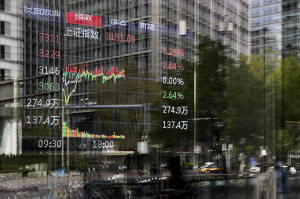Trump hits back with a 125% tariff in escalating trade war with China
[April 10, 2025] By
HUIZHONG WU
BANGKOK (AP) — President Donald Trump raised the tariff on Chinese
imports to 125% on Wednesday, hours after China boosted the duty on
American goods to 84% in an escalating battle that threatens to disrupt
trade between the world's two largest economies.
Citing a lack of respect, Trump set China apart from other countries. He
said in a social media post that he is pausing his so-called “reciprocal
tariffs” on many other trading partners because they had responded by
reaching out for talks rather than retaliating.
The tit-for-tat hikes between the U.S. and China are the latest in an
ongoing trade war that threatens to raise prices for consumers in
America and derail China’s attempts to reinvigorate its sluggish
economy. The response from the Chinese government signals its
determination not to bend to Trump’s pressure, despite the risks.
“If the U.S. insists on further escalating its economic and trade
restrictions, China has the firm will and abundant means to take
necessary countermeasures and fight to the end,” China's Ministry of
Commerce said before announcing its latest tariff hike.
In Washington, White House press secretary Karoline Leavitt said: “When
you punch at the United States of America, President Trump is going to
punch back further."
China is a major exporter to the US but no longer No. 1
The United States sent a record $199 billion in exports to China last
year, while China exported $463 billion in goods and services to the
United States, third behind Mexico and Canada, according to the U.S.
Commerce Department.

Top U.S. exports to China in 2024 included soybeans, aircraft,
pharmaceuticals and semiconductors. In the other direction, mobile
phones, computers, toys and clothing were among major imports from
China. The manufacturing giant was the top source of U.S. imports as
recently as 2022 but it has lost ground to America’s neighbors amid
heightened tensions with the United States.
The European Chamber of Commerce in China accused the U.S. of rolling
back many of the principles that have underpinned its approach to trade
and investment. It said that Trump's tariffs would have a significant
impact on European companies exporting from China to the U.S., forcing
them to rethink their business models and supply chains.
“This will lead to a substantial increase in operational costs and
inefficiencies, and ultimately higher prices for consumers,” it said.
No ‘easy path’ to restarting U.S.-China trade talks
Though the U.S. and China may want to find a way back to the negotiating
table, "this won’t be an easy path to navigate with both countries
doubling down and bilateral engagement at a virtual standstill,’’ said
former U.S. trade official Wendy Cutler, a vice president at the Asia
Society Policy Institute.
China does not appear interested in bargaining, as some other countries
have started doing.
“If the U.S. truly wants to resolve issues through dialogue and
negotiation, it should adopt an attitude of equality, respect and mutual
benefit," Foreign Ministry spokesperson Lin Jian said.

[to top of second column] |

Pedestrian and office buildings are reflected on a brokerage house's
window as an electronic board displays Shanghai shares trading index
in the Central Business District, in Beijing, Wednesday, April 9,
2025. (AP Photo/Andy Wong)
 The Chinese Ministry of Culture and
Tourism issued a travel advisory asking its citizens to evaluate the
risks of visiting the U.S. as tourists and to exercise caution. The
advisory, which came shortly after the announcement of China's
latest tariff hike, cited the deterioration in economic and trade
relations as well as the “safety situation” in America.
China's response has gone from measured to tough
Trump has now raised the tariff on Chinese goods five times since
taking office in January. The first two hikes of 10% each were met
with what analysts described as a measured response from China that
left the door open for talks.
But after Trump announced an additional 34% duty on Chinese goods
last week, along with tariffs on other countries in his “Liberation
Day," China matched that with a 34% tariff on imports from the U.S.
Trump then added a 50% tariff on goods from China, saying
negotiations were terminated, and bringing the cumulative U.S.
tariff to 104%. China responded by raising the tariff on American
products by the same amount, bringing its total rate to 84%. Then
Trump upped the American tariff to 125%.
China said it was also launching a new challenge to the U.S. tariffs
at the World Trade Organization and adding 11 American companies to
an “unreliable entities” list that bars Chinese companies from
selling them goods that could have military uses. Among the
companies are American Photonics, and SYNEXXUS, which both work with
the American military.
The trade dispute has set back efforts to resolve a standoff over
the TikTok short video app.
Trump signed an order last week to keep TikTok running for another
75 days after a potential deal to sell the app to American owners
was put on ice. Representatives from ByteDance, the Chinese company
that owns the app, told the White House that Beijing would no longer
approve a deal until there could be talks on trade.

“History and facts have proven that the United States’ increase in
tariffs will not solve its own problems,” the Commerce Ministry said
Wednesday. “Instead, it will trigger sharp fluctuations in financial
markets, push up U.S. inflation pressure, weaken the U.S. industrial
base and increase the risk of a U.S. economic recession, which will
ultimately only backfire on itself.”
___
Associated Press writers Didi Tang and Paul Wiseman in Washington
and researcher Yu Bing and video producer Liu Zheng in Beijing
contributed to this report.
All contents © copyright 2025 Associated Press. All rights reserved |